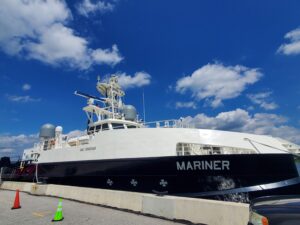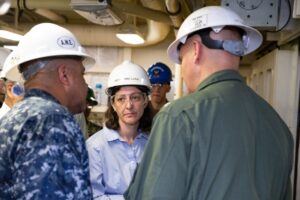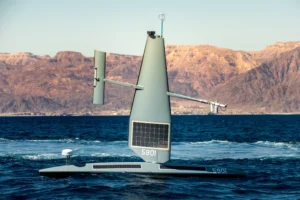A top Democrat on the House Armed Services Committee recently said while she sees some utility in unmanned surface vessels (USVs), she does not see a big place for them in the near term while the Navy’s top officer said testing is helping teach how to use and operate USVs in the real world.
“I definitely think that there is a place in the future to have some amount of unmanned surface vessels that provide some capability, but I think that our fleet is a manned and crewed fleet and it should and will stay that way, for the foreseeable future,” Rep. Elaine Luria (D-Va.), vice chair of the House Armed Services Committee, said during a virtual Defense One
event on Sept. 14.

Luria said she still agrees with investing in research and development of those types of technologies, but said her experience serving in the Navy means she does not see a large force of larger unmanned ships being useful for some time.
“As someone who’s served on six different ships, understands the maintenance challenges of operating at sea in that environment and transiting long distances, and the Navy’s reticence to even go from a fully manned to a smart ship concept. And we kind of always test these things out and go back to saying, like, well, we need more people. And until there’s a significant mindset shift there, I don’t really see that happening.”
She argued the purpose of larger unmanned ships, like the medium and larger unmanned surface vessels (MUSVs and LUSVs) “hasn’t been clearly articulated in my mind to Congress.”
While unmanned aerial vehicles (UAVs) have been adding capacity and service for many years and Unmanned Underwater Vehicles (UUVs) also have provided capacity, USVs are more unclear to her.
If USVs are meant to increase firepower as an adjunct arsenal, Luria sees other ways to increase the firepower on manned naval vessels.
“People are always counting [Vertical Launch Systems, or VLS] cells as a measure of the amount of capacity we have, and I did some analysis of the number of ships the Navy’s planning to decommission with the decommissioning of the cruisers as well as the [guided-missile submarines]. For example, we stand to lose 1,686 VLS cells between now and 2027….and 1,980 VLS cells between now and 2035. So huge amount of capacity that we could lose,” Luria said.
In February, Chief of Naval Operations Adm. Michael Gilday argued focusing on divestments of ships with VLS cells is too narrow given plans to procure Block V Virginia-class submarines with additional VLS tubes, Constellation-class frigates, Flight III destroyers, investments in Standard Missile-6 missiles and maritime strike Tomahawk missiles, and hypersonic missiles planned to go to the three Zumwalt-class destroyers later this decade (Defense Daily, Feb. 23).

Last year, Vice Admiral James Kilby, deputy Chief of Naval Operations for Warfighting Requirements and Capabilities (OPNAV N9), said also that the cruisers in question have had serious maintenance issues that affect ship safety and can only use their VLS cells if underway and not back in port for unexpected repairs related to age (Defense Daily, June 17, 2021).
Luria noted she inserted a study into the House’s version of the Fiscal Year 2023 defense authorization bill to investigate if VLS cells can be placed on Spearhead-class Expeditionary Fast Transport (EPF) ships as an alternative to increase firepower over LUSVs or keeping cruisers.
“It seems that the configuration of that platform could support that.”
Luria said the Navy could either control missile launches directly from EPFs or remotely control the launching from other platforms.
“I think these are all things we can work through technologically, certainly within our capability.”
Luria also noted that in recent weeks Iran tried to take Saildrone USVs in the Fifth Fleet Area of Operations (Defense Daily, Aug. 30).
“Some other Navy ships, the [Patrol Coast ships], which are slated for decommissioning, had to go out and essentially rescue it, because Iranian vessels were trying to capture this unmanned surface vessel. So I think there’s a lot of things we have to work through in determining if there really is a big place for unmanned surface vessels.”
Also speaking at the event on Sept. 14, Chief of Naval Operations Adm. Mike Gilday admitted protecting USVs from adversaries will be a challenge but in the Saildrone case they had a plan.
“Well, we did have a response plan, we actually put it into effect when the Iranians grabbed two of those Saildrones. That is going to be a challenge for us.”
Gilday argued the Navy is learning from the experience “and we’ll be applying that as we design and grow the unmanned fleet. What we’re trying to do is we’re trying to move fairly quickly, and to learn in this critical decade, so that we can apply what we learn very quickly, and take technologies that work and double down on them, and those technologies that don’t work to sundown them.”

Gilday reiterated his past statements that LUSVs could potentially be a sort of missile truck in the future while MUSVs potentially have the capability to feature electronic warfare or “some type of command or control features to it. But we’re learning things, with respect to command and control, in particular, with the effort in the Middle East right now, that’s helping us understand how we would apply those same principles to these larger vessels.”
The Navy is testing unmanned vessels and artificial intelligence systems in the Fifth Fleet via Task Force 59, including using Saildrone vessels.
The CNO said security for larger USVs is another aspect of what the service is figuring out with these tests.
“Security is another aspect of it – whether these vessels would initially be minimally manned, whether they would be part of a Surface Action Group, a Carrier Strike Group, or an [Amphibious Ready Group] so they wouldn’t be out there alone and unafraid, if you will, and so at the same time that we are driving down technical risk, and we’re learning a lot with respect to platforms, command and control, software and AI integration. We’re also refining our concepts of operation. It’s not perfect, but we’re trying to move here fairly quickly in a difficult decade.”